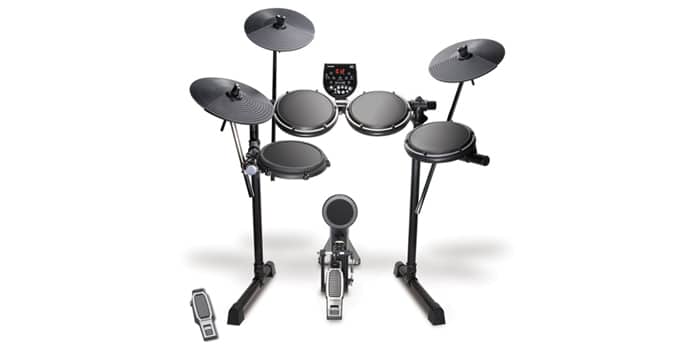
We may earn a commission from the affiliate links on this site. Learn more›
I’m writing this in the middle of a COVID Lockdown in London. I’m in my row house, on a quiet suburban street.
Like most people in the UK, I—and my neighbors on both sides—are working from home.
The outside world feels whisper-quiet right now.
There are no gigs taking place. Rehearsals are canceled, and recording sessions have ground to halt. Oh, and by the way: my practice room is closed for the foreseeable, too!
For the average musician, this is a tricky situation to work with. For a drummer? It’s nearly impossible!
At the moment, practicing in my house feels a little bit like sneezing in a library—you feel bad doing it, and you kind of regret it afterward.
No one wants to be ‘that guy’ in their street. Especially not right now. I miss my acoustic kit, and sometimes I’m tempted to throw caution to the wind—to set it up in my dining room and throw down a few solid rock grooves for old time’s sake.
Up until now, I’ve managed to resist! Still, there’s an opportunity in every challenge, and this current lockdown has, at least, presented me with a chance to try out some different practice methods and to work on my pad routine.
It’s also given me the chance to try out some exciting alternatives to that big old acoustic kit of mine.
You see, back in September—motivated by my neighbor’s need for a quiet life and my insatiable desire to drum—I picked up a second-hand Alesis DM6 for $200.
Today, right now, I’m going to tell you if it was worth it. I’m also going to consider whether even pro-level drummers could benefit from dipping into the very budget end of the electric market from time to time.
But before I tell you all about this old veteran of the budget kits, I should start from the top.
Alesis DM6 Overview and Review
Don’t feel bad if you’ve not come across the DM6 before—it’s not so surprising. Alesis first released it in 2009, and it’s now discontinued (with the Nitro model taking over instead).

You won’t find it in many stores now, but it’s still pretty popular on the second-hand market.
It’s an unashamedly budget-level kit, and the Nitro mentioned above is just one modern equivalent that is considered superior in terms of sound quality and features.
Nevertheless, the DM6 is still rugged, and—overall—it represents a pretty good choice of purchase, especially considering the low price that they tend to sell for.
What’s Under the Hood?
The DM6’s spec is modest by today’s standards.
It features a mere ten preset kits, holds 108 separate drum and percussion voices, and although each kit is fully customizable, there are only five blank slots available for saving these custom kits.
There are 40 preset songs if you want to play along with those, but there’s no ‘learning mode’ which comes—as standard—on many modern equivalents.
Almost all the pads are ‘single zone,’ so most of them illicit only one sound per drum. You can’t, for example, play on the side of a pad to simulate striking a tom hoop, and you don’t get different tones if you hit the pads in other places.
There are two dual-zone pads, though.
The snare pad is one of these, meaning you can play rimshots or cross-sticking alongside the standard, center-snare sound.
The ride pad is also dual-zone, and you can use this to play the bell of the ride as well as the edge—although this is pretty hard to do, and sometimes the bell triggers by mistake!
The module interface is simple and well organized. There’s a volume knob and a click on/off button. There are also buttons for scrolling through drum kits and drum voices for increasing and decreasing the volume of
individual pads and for muting and un-muting the drums in the aforementioned play-a-long songs.
Finally, and thankfully, the kit is connective considering its low price point: there’s a headphone out, a mini-jack output, and a mini-jack input so you can plug your iPod/iPad into the kit and play along with tracks that way.
There’s also a MIDI output, which is, in my opinion, the holy grail of budget electric kits (more on that later).
So, What’s It Like?
Firstly, the DM6 is a breeze to set up. It shouldn’t take long to get it up and running, and it’s pretty easy to get everything into a comfortable playing position, something which isn’t always the case with electric kits.
Unfortunately, I tend to find that the wingnuts holding each pad in place come loose fairly easily, causing them to droop a little.
It’s not a huge deal, but it can be a pain when you have to re-tighten them after each session.
In general, despite the wingnut problem, the kit feels pretty solid.
Remember, we’re talking about something which costs $200 second-hand here. It wouldn’t survive a fight with a gorilla but, as long as you’re sensible, it feels like it’ll stand up to most things.
The snare pad feels especially nice under the stick—like a quilted practice pad. It feels sturdy too, and it invites you to play with conviction.
The toms also feel pretty nice, though maybe not quite so solid as the snare pad, and the plastic rims (not present on the snare) can get in the way as you move around the kit.
The kick pad is sturdy and big enough to accommodate a double pedal if that’s your thing. The cymbals are a little annoying, though. They feel disconcertingly fragile, but, again, if you’re sensible, they should be okay.
Thankfully they’re interchangeable with similar pads, and it’s reassuring to know that you can always buy replacement pads online if needed.
Apart from their apparent fragility, you can’t choke the cymbals. That’s a shame because it would’ve added some extra authenticity to the playing experience.
The hi-hat and kick pedals that come with the kit are pretty substantial, and I was honestly surprised by the kick pedal’s weight and speed in particular. It’s not particularly sluggish or frustratingly slow. It wouldn’t survive a stadium tour, and it might not be your go-to weapon for hard and fast playing, but it does the job well, and it’ll allow you to play most grooves and fills without much effort.
So that’s the hardware, but what about the sound module?
The Brains of the Operation – DM6 Drum Module
As noted before, the DM6’s interface is simple but intuitive. Scrolling through the various menus for changing kits, individual drums, and songs is as easy as one, two, three… quite literally!
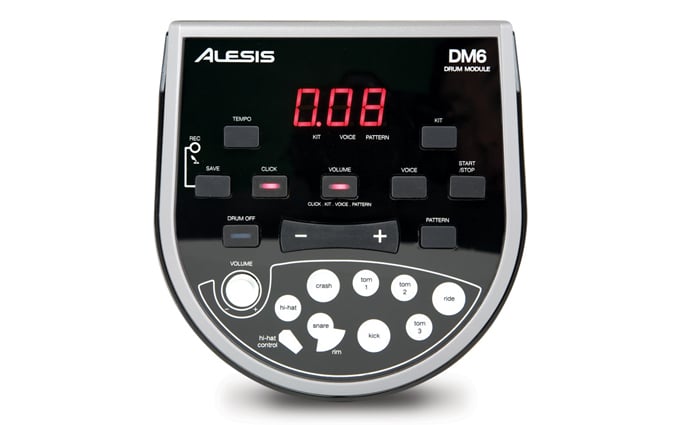
There are no surprising features here, and the menus don’t throw open a vast ocean of exploration, but everything’s easy to find and navigate, all the same.
The ten preset kits are quite diverse, and it’s enjoyable to scroll through them and play around for a while.
As usual, you’ll find a rock kit, a metal kit, a jazz kit with brush sounds, a couple ‘world music’-like percussion kits, and one or two crazy, electro-sounding kits with DJ vinyl scratches and weird noises.
What’s it Like to Play?
The DM6 offers a pretty fun playing experience. I’m a sucker for the variety of sounds that are available on electric drum kits. I can gladly sit around for an hour, scrolling through everything, trying out different grooves and fills like a kid in a candy store.
The pads are pretty responsive, and they have a relatively wide dynamic range. In truth, they don’t always trigger when played.
This problem is especially true of the cymbals: it seems as though they need to be played harder than everything else on the kit, or else they don’t respond very consistently.
Even so, I found myself performing ghost strokes, drags, and accents with relative ease. The pads respond well to faster playing, and they don’t usually miss notes when you’re, for example, firing a quick double stroke roll off around the kit. So far, so good then.
How Does it Sound?
Unfortunately, despite the fun playing experience, the DM6 doesn’t sound so great. Sure, everything sounds like it’s meant to sound, but most of the drums on most kits sound digital, cold, and artificial.
The toms sound especially hollow, and the cymbals all sound a little like something from an 80s dance track.
It’s like the difference between fresh orange juice and an orange-flavored drink—one is the real deal, one isn’t: and the difference is clear.
The previously mentioned play-a-long songs follow the same sound quality trend, and they’re cornier than a Korn concert in a cornfield.
They’re pretty fun to jam with, and, to be fair, I don’t think I’ve ever heard a built-in song on an electric kit that sounds great—even on the upper end of the spectrum. So the DM6 doesn’t perform too poorly here, in my opinion.
The thing is, at this price, none of this is a huge shock.
The important thing is that the drums sound like drums, the songs sound like songs, and it’s a pretty fun kit to play around with.
Pro Potential?
Earlier, I mentioned that MIDI connectivity is, in my opinion, the holy grail of budget electric kits. The DM6 has it, and this does wonders for the kit’s potential. You can plug the DM6 into your laptop or MacBook and expand your options ten-fold.
You might have to pay a little more money, but by downloading a couple of decent drum libraries or drum VSTs onto your hard drive, you can transform the sound of the kit.
Similarly, if you use Logic, Pro Tools, or any other DAW, you can use the kit for recording midi, and the results are excellent.
Okay, so it’s not the same as recording an acoustic kit in a pro-environment, but I think the results would satisfy most pairs of ears—especially in busier musical arrangements, where the kit sound isn’t in the spotlight so much.
For me, this has been one of the most fun aspects of DM6 ownership. I’ve programmed midi drums on Logic countless times, and it can take a lot of leg work and editing to make things sound authentic. Recording MIDI with an electric kit makes life so much easier!
Here, almost everything is tracked in real time and, although it’ll still take a little editing to get things up to scratch, it’s far easier (and more fun) than programming with a keyboard and mouse.
I recently used the DM6 paired with a sound library to record a track for a songwriter friend. He was super pleased with the results.
Who’s the DM6 Really For, Then?
On the face of it, the DM6 is aimed at beginner and low intermediate level players. If that’s you, I think you’ll be thrilled with this kit.
Yes, you could read above and see me complaining about the tone of the drums and the cymbals’ fragility, but that really shouldn’t worry most people in the early stages of drumming life.
The drums still sound like drums, and the cymbal pads will still stand up to sensible playing. You might be tempted to part with extra money and buy the more recent Alesis Nitro, but that’s a cost vs. benefit decision. I’ve played both, and I wouldn’t call it an open-and-shut case.
If you’re torn, it’d be worth trying to play a couple of different kits yourself to inform your decision.
Either way, I don’t think that most early drummers would be at all unhappy with the DM6.
If you’re a more advanced intermediate player, you might find the kit a bit limiting. I bought mine from an intermediate-level student, who found certain aspects off-putting.
Usually, this was because the pads didn’t always register the playing of a note or because specific techniques, like cross sticking, aren’t played in the same way as we would play them on an acoustic kit.
With that in mind, surely a professional drummer wouldn’t be happy with the lowly Alesis DM6, would they…? That’s a trickier question.
If, like me, you’re looking for some quiet practice at a low price point, this kit may be worth a look. It’s not a high-end Roland or an expensive Yamaha kit, but it is dirt cheap, and the playing experience isn’t so bad.
Sure, the kit doesn’t always replicate what I play—sometimes individual strokes disappear or don’t trigger, you can’t choke the cymbals, half-open the hi-hat, or conventionally perform a cross-stick.
The tone of the kit isn’t great either. But it’s relatively easy to set up and pack away, so it doesn’t take up much space, and it’s comfortable enough to play.
When the kit doesn’t register a stroke that I’ve played, I’m not that bothered because I know what the stroke would’ve sounded like on an acoustic kit, and that’s my main concern.
In that way, I’ve been using the DM6 as a practice pad kit which makes bonus noises. Let’s not forget the MIDI output, which opens up the possibility of better drum sounds and the option to record.
Based on all of these factors, I think that many pro drummers could find a use for it, as long as expectations aren’t too high.
Finally, in a COVID pandemic which feels a little like a post-apocalyptic dystopia, where no one’s allowed to meet up and where my primary source of company is my faithful dog, the DM6’s little flashing LED’s remind me of a weird-looking R2-D2 and, right now, having a kindly old android around the house is a bonus.
Maybe I’m cracking up under the strain of world events, or maybe there’s something weird in the water supply, but I honestly like the Alesis DM6, and I’ll happily use it for a little practice, a little remote recording, and a lot of fun.

About the Author
Chris Witherall is a pro drummer, producer and songwriter from London, England. He loves talking about music, and helping people to reach their music goals.

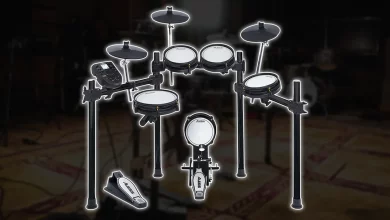
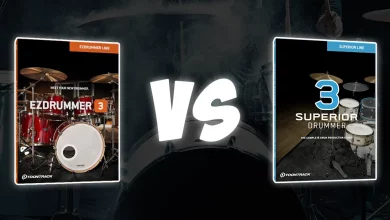
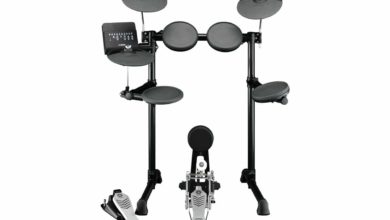
Thanks for the review. I think i agree from the entry level and price point factors before reaching for passion driven and financial expense. I agree Midi option will help grow into drumming stages. Look forward into seeing what it can do. Thanks.
0
Well that’s settled it. I was looking around for a used Nitro kit (I’m a beginner) and found one of these locally for $120. Never even used, apparently.
0
Great review that helped a lot when I came over a set very cheap. I am a 59 years old beginner, but it is never to late to learn something new and so far I have had a lot of fun. For me these drums are more than enough but it is good o know that even a pro can find use for these drums. Thanks again.
0